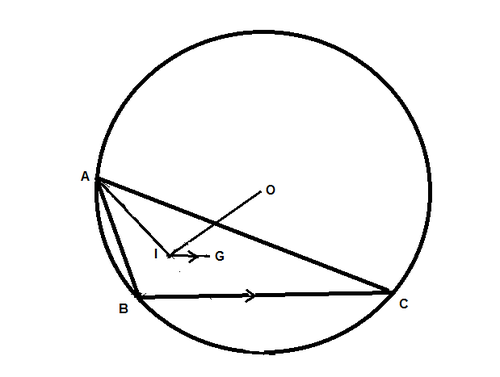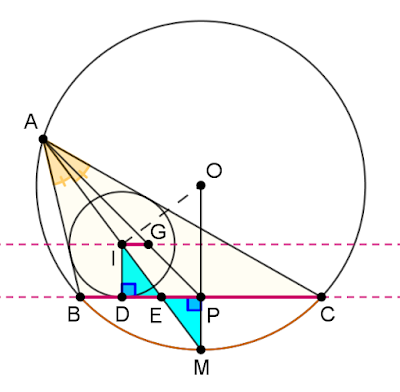An Interesting Triangle
In △ A B C , I is the incentre, G the centroid and O the circumcentre. If the line I G is parallel to B C then determine the measure of ∠ A I O .

This section requires Javascript.
You are seeing this because something didn't load right. We suggest you, (a) try
refreshing the page, (b) enabling javascript if it is disabled on your browser and,
finally, (c)
loading the
non-javascript version of this page
. We're sorry about the hassle.
2 solutions
@ajit athle Nice problem! See my solution. The congruency of the blue triangles establishes that M P = r .
Thanks a million, Thanos.
Let
M
be the point where the angle bisector
A
E
meets the circumcircle of
△
A
B
C
when extended. Then,
M
is the midpoint of
BC
⌢
and line
O
M
is the perpendicular bisector of
B
C
, hence, the point of intersection of
O
M
and
B
C
is the midpoint
P
of
B
C
.
Let, also,
D
be the point of tangency of the incircle with side
B
C
. Finally, denote
A
B
by
c
,
B
C
by
a
and
C
A
by
b
.
 The claim is that
∠
A
I
O
=
9
0
∘
.
The claim is that
∠
A
I
O
=
9
0
∘
.
To prove it, we just have to show that
O
I
is the apothem of chord
A
M
, or, equivalently, that
I
is the midpoint of
A
M
.
Further down we‘ll use the following formulae:
Distance of the incenter from a vertex A I = a + b + c b + c ⋅ A E ( 1 ) B E = b + c a c ( 2 ) B D = s − b = 2 a − b + c ( 3 ) where s is the semiperimeter of △ A B C , i.e. s = 2 a + b + c .
Since I G is parallel to B C , we have
A E A I = A P A G ⇒ ( 1 ) a + b + c b + c = 3 2 ⇒ b + c = 2 a ( 4 ) .
Now, D E = B E − B D = ( 1 ) , ( 2 ) , ( 3 ) b + c a c − 2 a − b + c = ( 4 ) b + c c 2 b + c − 2 2 b + c − b + c = 4 b − c ( 5 ) On the other hand, E P = B P − B E = ( 2 ) 2 a − b + c a c = ( 4 ) 2 2 b + c − b + c 2 b + c c = 4 b − c ( 6 )
( 5 ) , ( 6 ) ⇒ D E = E P .
This implies that the blue right angled triangles △ I D E and △ M P E are congruent, thus, I E = E M .
We have reached our goal, since
A E A I = 3 2 ⇒ A I = 2 I E = I E + E M = I M , i.e. I is indeed the midpoint of A M Q.E.D.
Note: Please, ask if you want me to include a proof of formula ( 1 ) , or any other.
Extend AI to meet the circle in M, the midpoint of smaller arc BC. Further, Join M to O and produce it to meet the circumcircle in N. Let the in-circle touch AB in L. From M draw a perpendicular to BC meeting the latter in P. Now we can see that Tr. AIL///Tr. NBM; AI MB=IL NM=2r R. We further observe that MP=r since GI//BC and thus r/MB=sin(A/2) as also r/AI=sin(A/2) which implies that AI=MB & therefore AI²=2r R. We now recall by Euler's Formula : OI²=R² -2r*R or OI²=R²-AI² or AI²+OI²=R² or /_OIA =90° by the converse of Pythagoras Theorem.
This proof is incomplete and I would be grateful if someone can establish why MP = r